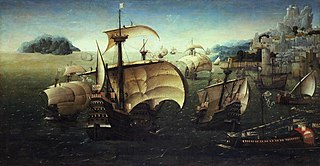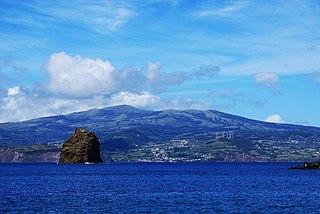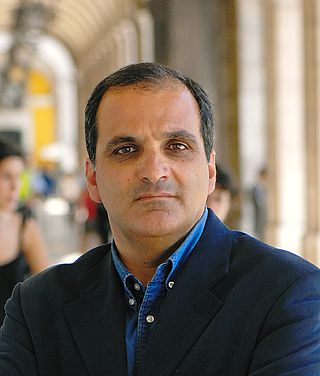
Dom Henrique of Portugal, Duke of Viseu, better known as Prince Henry the Navigator, was a central figure in the early days of the Portuguese Empire and in the 15th-century European maritime discoveries and maritime expansion. Through his administrative direction, he is regarded as the main initiator of what would be known as the Age of Discovery. Henry was the fourth child of King John I of Portugal, who founded the House of Aviz.

The history of the Kingdom of Portugal from the Illustrious Generation of the early 15th century to the fall of the House of Aviz in the late 16th century has been named the "Portuguese golden age" and the "Portuguese Renaissance". During this period, Portugal was the first European power to begin building a colonial empire as during the Age of Exploration Portuguese sailors and explorers discovered an eastern route to India as well as several Atlantic archipelagos and colonized the African coast and Brazil. They also explored the Indian Ocean and established trading routes throughout most of southern Asia, sending the first direct European maritime trade and diplomatic missions to Ming China and to Japan, at the same time installing trading posts and the most important colony: Portuguese Macau. The Portuguese Renaissance produced a plethora of poets, historians, critics, theologians, and moralists. The Cancioneiro Geral by Garcia de Resende is taken to mark the transition from Old Portuguese to the modern Portuguese language.

The Battle of Diu was a naval battle fought on 3 February 1509 in the Arabian Sea, in the port of Diu, India, between the Portuguese Empire and a joint fleet of the Sultan of Gujarat, the Mamlûk Burji Sultanate of Egypt and the Zamorin of Calicut.

A carrack is a three- or four-masted ocean-going sailing ship that was developed in the 14th to 15th centuries in Europe, most notably in Portugal and Spain. Evolving from the single-masted cog, the carrack was first used for European trade from the Mediterranean to the Baltic and quickly found use with the newly found wealth of the trade between Europe and Africa and then the trans-Atlantic trade with the Americas. In their most advanced forms, they were used by the Portuguese and Spaniards for trade between Europe, Africa and Asia starting in the late 15th century, before being gradually superseded in the late 16th and early 17th centuries by the galleon.

The Monument of the Discoveries is a monument on the northern bank of the Tagus River estuary, in the civil parish of Santa Maria de Belém, Lisbon. Located along the river where ships departed to explore and trade with India and the Orient, the monument celebrates the Portuguese Age of Discovery during the 15th and 16th centuries.

The naval Battle of Vila Franca do Campo, also known as Battle of Ponta Delgada and Naval Battle of Terceira Island, took place on 26 July 1582, off the coast of the island of São Miguel in the Portuguese archipelago of the Azores, during the War of the Portuguese Succession. A combined corsair expedition, mainly French, sailed against a Spanish naval force made up of Portuguese and Castilian ships, to preserve control of the Azores under the pretender António, Prior of Crato and to defend the islands from incorporation into the Iberian Union, the largest French force sent overseas before the age of Louis XIV.
Medieval ships were the vessels used in Europe during the Middle Ages. Like ships from antiquity, they were moved by sails, oars, or a combination of the two. There was a large variety, mostly based on much older, conservative designs. Although wider and more frequent communications within Europe meant exposure to a variety of improvements, experimental failures were costly and rarely attempted. Ships in the north were influenced by Viking vessels, while those in the south by classical or Roman vessels. However, there was technological change. The different traditions used different construction methods; clinker in the north, carvel in the south. By the end of the period, carvel construction would come to dominate the building of large ships. The period would also see a shift from the steering oar or side rudder to the stern rudder and the development from single-masted to multi-masted ships. As the area is connected by water, people in the Mediterranean built different kinds of ships to accommodate different sea levels and climates. Within the Mediterranean area during the Medieval times ships were used for a multitude of reasons, like war, trade, and exploration.

São João Baptista, nicknamed Botafogo ("Spitfire"), was a Portuguese galleon built in the 16th century, around 1530, considered one of the biggest and most powerful Portuguese warships.

São Gabriel was a Portuguese carrack and the flagship of Vasco da Gama's armada on his first voyage to India in 1497–1499.

The Portuguese Indian Armadas were the fleets of ships funded by the Crown of Portugal, and dispatched on an annual basis from Portugal to India. The principal destination was Goa, and previously Cochin. These armadas undertook the Carreira da Índia from Portugal, following the maritime discovery of the Cape route, to the Indian subcontinent by Vasco da Gama in 1497–99.

Due to centuries of constant conflict, warfare and daily life in the Iberian Peninsula were interlinked. Small, lightly equipped armies were maintained at all times. The near-constant state of war resulted in a need for maritime experience, ship technology, power, and organization. This led the Crowns of Aragon, Portugal, and later Castile, to put their efforts into the sea.

Throughout the early Age of Exploration, it became increasingly clear that the residents of the Iberian Peninsula were experts at navigation, sailing, and expansion. From Henry the Navigator's first adventures down the African coast to Columbus's fabled expedition resulting in the discovery of the new world, the figures that catalyzed the European appetite for expansion and imperialism heralded from either Portugal or Spain. However, merely a century earlier, nautical travel for most peoples was resigned to keeping within sight of a coastline and very rarely did ships venture out into deeper waters. The period's ships were not able to handle the forces of open ocean travel and the crewmen had neither the ability nor the necessary materials to keep themselves from getting lost. A sailor's ability to travel was dictated by the technology available, and it was not until the late 15th century that the development of the nautical sciences on the Iberian Peninsula allowed for the genesis of long-distance shipping by directly effecting, and leading to the creation of, new tools and techniques relative to navigation. Christopher Columbus’s famous expedition, which crossed the ocean in 1492, was arguably the first contact the civilized world had with the newly discovered continent. Financed and sponsored by Queen Isabella of Spain, his journey would open the door to new trading lanes, imperialist appetites, and the meeting of cultures. Portugal and Spain became the world's foremost leaders in deep water navigation and discovery because of their sailing expertise and the advancement of nautical sciences benefiting their ability to sail further, faster, more accurately, and safer than other states. Vast amounts of precious minerals and lucrative slaves were poured into Iberian treasuries between the late 15th and mid to late 17th centuries because of Spanish and Portuguese domination of Atlantic trade routes. The golden age of Portugal and Spain was a direct result of the advancements made in navigation technology and the sciences which allowed for deep water sailing.

The square-rigged caravel, was a sailing ship created by the Portuguese in the second half of the fifteenth century. A much larger version of the caravel, its use was most notorious beginning in the end of that century. The square-rigged caravel held a notable role in the Portuguese expansion during the Age of Discovery, especially in the first half of the sixteenth century, for its exceptional maneuverability and combat capabilities. This ship was also sometimes adopted by other European powers. Its hull resembled the shape of the later galleon and some scholars have claimed that this vessel is a forerunner of the fighting galleon, by the name of caravela de armada.

The Action of Faial or the Battle of Faial Island was a naval engagement that took place on 22–23 June 1594 during the Anglo-Spanish War in which the large and richly laden 2,000-ton Portuguese carrack Cinco Chagas was destroyed by an English privateer fleet after a long and bitter battle off Faial Island in the Azores. The carrack, which was reputedly one of the richest ever to set sail from the Indies, was lost in an explosion which denied the English, as well as the Portuguese and Spanish, the treasure.

Walter Rossa is architect, urban planner, researcher and Professor of University of Coimbra.

The Azores Voyage of 1589, also known as Cumberland's Third Voyage, was a series of conflicts in the Azores islands between August and September 1589 by an English military joint stock expedition led by George Clifford, 3rd Earl of Cumberland, during the Anglo–Spanish War. All the islands were attacked either for provisions or the attainment of Spanish and Portuguese prizes. A number of Portuguese and Spanish ships were captured and also included a battle at Faial, which resulted in the capture of the fort and the main town, which was subsequently sacked and burned. The English were able to return home unmolested with a total of thirteen prizes – the expedition was a success and with a good profit for the investors although many people died to disease and storms.

Maritime travel experienced a large leap in the capabilities of seafaring vessels thanks to technological improvements in shipbuilding in the early modern era. Europe, Asia, and the Middle East all saw improvements on prior construction techniques, contributing to the Age of Discovery. As a result, the introduction of these technologies in the production of naval vessels was critical as they allowed nations that utilized these advancements to ascend to a state that could expand its influence at a far greater range. In military engagements, the exploration of new lands and potential colonies, or the transportation of goods for trade, better shipbuilding techniques coincided with prosperity. It is during this time that the practice of naval architecture appeared, as skilled designers could produce designs that had an enormous impact in ship performance and capabilities.
Portuguese nautical science evolved from the successive expeditions and experience of the Portuguese pilots. It led to a fairly rapid evolution, creating an elite of astronomers, navigators, mathematicians and cartographers. Among them stood Pedro Nunes with studies on how to determine latitude by the stars, and João de Castro, who made important observations of magnetic declination over the entire route around Africa.
































